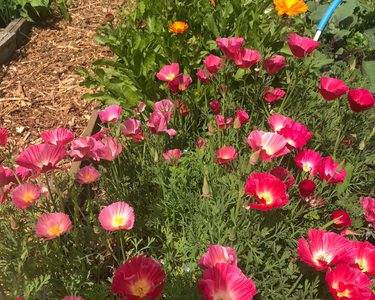Chris Collins on…encouraging biodiversity

After a cool, fresh spring, it’s fair to say it’s been a slower start to the season than I’ve been used to in recent years. But nature quickly catches up. Suddenly, over the last few weeks the trees around my balcony and at the bottom of my allotment are full of fledglings. They’re chirping their little hearts out and splashing in the water dishes that I leave out - and generally having a ball!
This is an absolute joy for me. You can keep your TV shows, fashion trends and all other ‘stuff’ the modern world throws at us - because seeing wildlife in action in a garden never gets boring. And what is a garden without its wildlife, without its biodiversity.
To encourage wildlife, I like to think of the adage ‘build it and they will come’. This year, a collaboration between myself and my allotment neighbour to put in a pond has, within weeks, proved invaluable. Young frogs are now a regular sight among the plants and even newts have put in appearance. No one put them there, all we did is build a pond and they came: along with the water boatmen, water snails, pond skaters and mayflies. It truly is biodiversity in action.
Chris’s pollinator paradise
For three years I’ve also created what I like to refer to as a ‘pollinator corridor’ at my plot. It sounds very flash, but it’s literally a thin strip that runs all the way along the side of my allotment and is purely to attract bees and the butterflies. I’ve planted with herbaceous plants such as valerian, Jerusalem artichoke and phlox but there’s also a few cannas, and single, pollen rich spring bulbs such as crocus. Then, I let the dandelions, plantago and speedwell make themselves at home as well. It’s deliberate that I run this biodiverse area the length of the plot as it allows access to pollinators to the entire allotment and not just a private party in a small space, tucked away to the side.
Of course, I cannot talk about encouraging biodiversity without mentioning hardy annuals. Cheap and direct sown - and always covered in insectivorous life - these are incredible plants, providing balance between predators and plant munchers. They are an integral part of my outdoor spaces and the best thing about them is they freely seed and reappear each year. Edited to my requirements, these seedlings contribute to my gardening spaces by providing a platform for biodiversity and if you want proof, check out the action on a sunflower or English marigold when they are in their full, floral glory!
These are some of the small steps we can take to make our garden spaces more nature friendly. And this year, Garden Organic will once again be at Gardeners’ World Live with our Backyard Biodiversity Garden, complete with examples such as native hedging, perennial edibles, and pollen-rich lawns.
We look forward to telling you more when you visit!